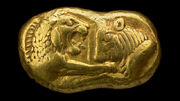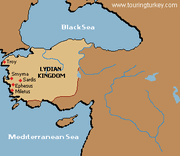Brief Identification[]
This coin also known as a croesid was discovered in Lydia, or modern day Turkey (Asia Minor

Gold coin of Croesus that was made around 550 BCE in the Lydian Empire.
) around 550 BCE. The gold coin was in minted in Sardis, the capitol of Lydia, and has been attributed to the King of Lydia, Croesus, who is given credit for creating the first coinage. Coins made in Lydia during the 6th century BCE were made of electrum The gold coin was stamped with a lion and a bull facing each other. The coins minted were used for trading and the paying of mercenary fighters in Lydian society. The coin is has a height of 1 cm and a width of 2 cm.
Technical Evaluation[1]Edit[]
The coins and most coins made in Lydian society by skilled workers practicing metallurgy were of electrum, which was an alloy consisting of gold and silver that was naturally mixed. The Lydian's had near access to the resources for coinage, "made from electrum, a natural alloy of gold and silver found in the River Pactolus that flowed by Sardis, Lydia's capitol" [see Iowa State University] during the mid-6th century BCE. Lydians would extract or retrieve the electrum from the river by panning to where it would be refined and made into coin.
The gold and silver extract was taken to a refiner by a Lydian specialist and would be flattened by a hammer on an anvil. By pounding the pieces of metal they would become flat allowing the electrum to have a higher purification when heated. The flat sheets of metal would be placed in a furnace where it would be smelted to remove the impurities. Smelting the gold and silver was a very crucial step in making coins during the 6th century BCE because the value of the coins depended on the purity of the metal. After being smelted the nugget of gold and silver would be hit by a punch on an anvil imprinting or "stamping" the emblem of the lion and bull.
It is believed that the first coins were minted in Lydia, "although the archaeologists have not found hoards of gold or splendid palaces", [see Cornell University] archeaologists have found in the ruins of the ancient city of Sardis many gold refineries, and furnace artifacts have been found proving that coins were minted during Croesus's rule of Lydia. (ANYONE CAN EDIT THIS SO MAKE SURE TO FACT CHECK)
Local Historical Context[2]Edit[]
During the Mermnad Dynasty in the 6th century BCE, the King of Lydia was Croesus from 560 BCE - 546 BCE. The area he ruled then was called Asia Minor, or Anatolia, which is present day Turkey. The Lydian's were feared warriors who were very skilled in horse and chariot warfare and controlled the area between Greece and Persia. Under the rule of Croesus, the Mermnad Dynasty expanded its borders by starting military campaigns in Ephesus and then in Aeolian and Ionian cities transforming Lydia into an empire. The Lydian Empire had such a large army, it is thought that Croesus started to mint coins to pay his soldiers and

Map of the Lydian Empire during the 6th century BCE.
mercenary fighters.
Croesus imposed taxes on the fringes of his empire, which was the Lydian"s main source of income. Croesus used the money received from taxes to power his empire"s military while also being a patron of art spending money to reconstruct the Artemis Temple in Ephesus.
Lydia being in such a pivotol location in Anatolia and along the Aegean , trade flowed through the empire, and "there was a vigorous trade between Ionian City States and the Lydian Kingdom." [see World Coin Catalog] International trade at this time facilitated the movement from a barter system to a more efficient trading system with coin. German historian Ernst R. Curtius wrote, "The Lydians became on land what the Phoecians were by sea, the mediators between Hellas and Asia."
The expression, "As rich as Croesus" signifies the economic state Lydia was in during Croesus' rule but also the amount of wealth Croesus possessed himself.
World-Historical Significance[3]Edit[]
After Croesus was defeated by the Persians under Cyrus the Great in 546 BCE, coinage spread from Lydia. "During the 6th and early 5th centuries it was adopted by neighbouring peoples of Asia Minor, such as the Lycians. From the Greeks of coastal Asia Minor it spread throughout the Greek world." [see Iowa State University] The creation of coinage in Lydia played a large role in the economic developement of the world and still plays a factor in todays society. Coinage encouraged a movement from the barter system to a system of money. The introduction of coins allowed for a standard currency to be made so that all merchants, political systems, and rulers could make transactions less difficult. The standardization of coins had benifits such as, "preventing merchants having to weigh bullion with each transaction." [see World's First Coin] The gold coins made by Croesus have had an everlasting affect on the way monetary systems have been run since the technology of coinage was first made in the 6th century BCE. The making of coins under Croesus' rule influenced the standardized money system of ancient times, the introduction of the gold standard in 1870 CE, and the introduction of the U.S. dollar. All of these effects can be derived from the first making of coins in Lydia under the rule of Croesus.
Bibliography[4]Edit[]
2010. "Sardis." Columbia Electronic Encyclopedia, 6th Edition 1. Literary Reference Center, EBSCOhost (accessed April 18, 2011).
Jed, Stevenson. 1991. "Coins." New York Times, October 13. 69. Newspaper Source Plus, EBSCOhost (accessed April 20, 2011).
Iowa State University, "Gold Standard," http://www2.econ.iastate.edu/classes/econ355/choi/golds.htm
Wilford, John Noble. 2000. "The Secrets of Croesus' Gold." New York Times (Front Page, Morning Edition), August 15. F1. EDS Foundation Index, EBSCOhost (accessed April 18, 2011).
Cornell University, "Ancient King's Legendary Gold," Last modified Aug 15, 2000 http://www.library.cornell.edu/colldev/mideast/sardis.htm
"Gold Croesid Coin," The British Musuem. Accessed April 10, 2011. http://www.britishmuseum.org/explore/highlights/highlight_objects/cm/g/gold_croesid_coin.aspx
"CROESUS." (n.d.): Funk & Wagnalls New World Encyclopedia, EBSCOhost (accessed April 20, 2011).
Metropolitan Museum of Art, "Sardis," http://www.metmuseum.org/toah/hd/srds/hd_srds.htm
Britannica Online, "Croesus," http://www.britannica.com/EBchecked/topic/143732/Croesus
World Coin Catalog, "Lydia," http://worldcoincatalog.com/AC/C4/Lydia/Lydia.htm
World's First Coin, "The Lydian Lion," http://rg.ancients.info/lion/article.html
"LYDIA." (n.d.): Funk & Wagnalls New World Encyclopedia, EBSCOhost (accessed April 20, 2011).
Anatolia, "Lydian Period," http://www.ancientanatolia.com/historical/lydian_period.htm